Call Us Today! (203) 975-9600
SAME DAY APPOINTMENTS AVAILABLE
October 2023
Definition and Common Causes of Poor Circulation
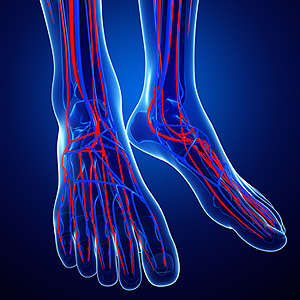
Poor circulation, a medical condition also known as circulatory insufficiency, refers to the inadequate flow of blood through the blood vessels, impairing the distribution of oxygen and nutrients to the body's cells and organs. The feet are often affected, leading to a variety of symptoms, including numbness, tingling, and muscle cramps. Several factors can contribute to poor circulation. Atherosclerosis, the buildup of plaque in arteries, narrows the blood vessels, reducing blood flow. Conditions such as diabetes can damage blood vessels and nerves, further impeding circulation. High blood pressure, obesity, and smoking are well-known risk factors that can harm blood vessels and hinder the circulatory system. In some cases, genetics can play a role, as a family history of circulatory issues may increase one's susceptibility. If your feet are cold for the majority of the day, it is suggested that you schedule an appointment with a podiatrist who can accurately diagnose poor circulation, and offer appropriate treatment methods.
While poor circulation itself isn’t a condition; it is a symptom of another underlying health condition you may have. If you have any concerns with poor circulation in your feet contact one of our podiatrists of Preferred Footcare, LLC. Our doctors will treat your foot and ankle needs.
Poor Circulation in the Feet
Peripheral artery disease (PAD) can potentially lead to poor circulation in the lower extremities. PAD is a condition that causes the blood vessels and arteries to narrow. In a linked condition called atherosclerosis, the arteries stiffen up due to a buildup of plaque in the arteries and blood vessels. These two conditions can cause a decrease in the amount of blood that flows to your extremities, therefore resulting in pain.
Symptoms
Some of the most common symptoms of poor circulation are:
- Numbness
- Tingling
- Throbbing or stinging pain in limbs
- Pain
- Muscle Cramps
Treatment for poor circulation often depends on the underlying condition that causes it. Methods for treatment may include insulin for diabetes, special exercise programs, surgery for varicose veins, or compression socks for swollen legs.
As always, see a podiatrist as he or she will assist in finding a regimen that suits you. A podiatrist can also prescribe you any needed medication.
If you have any questions, please feel free to contact our office located in Stamford, CT . We offer the newest diagnostic and treatment technologies for all your foot care needs.
Is Your Heel Pain From Plantar Fasciitis?
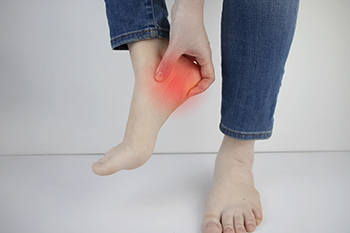
Determining the root cause of heel pain can be challenging, especially when other conditions like arthritis or tarsal tunnel syndrome come into play. Plantar fasciitis is a leading culprit behind heel pain. It is characterized by sharp pain, inflammation, and tenderness in the sole of the foot, particularly near the heel. Notably, the pain is most pronounced during the first few steps in the morning or after prolonged periods of sitting. Unlike osteoarthritis, which tends to worsen with movement, plantar fasciitis pain often improves as you walk around but worsens later in the day. The condition arises when the plantar fascia, the ligament connecting the heel to the ball of the foot, loses its elasticity and develops tiny tears. These tears lead to painful swelling in the ligament. Diagnosis by a podiatrist may involve a thorough medical history, a physical examination, including range-of-motion tests, and sometimes an X-ray. The good news is that most people with plantar fasciitis find relief through non-invasive, non-surgical treatments. If you suspect you may have developed plantar fasciitis, it is suggested that you make an appointment with a podiatrist for an exam, a diagnosis, and suggested treatment options.
Plantar fasciitis is a common foot condition that is often caused by a strain injury. If you are experiencing heel pain or symptoms of plantar fasciitis, contact one of our podiatrists from Preferred Footcare, LLC. Our doctors can provide the care you need to keep you pain-free and on your feet.
What Is Plantar Fasciitis?
Plantar fasciitis is one of the most common causes of heel pain. The plantar fascia is a ligament that connects your heel to the front of your foot. When this ligament becomes inflamed, plantar fasciitis is the result. If you have plantar fasciitis you will have a stabbing pain that usually occurs with your first steps in the morning. As the day progresses and you walk around more, this pain will start to disappear, but it will return after long periods of standing or sitting.
What Causes Plantar Fasciitis?
- Excessive running
- Having high arches in your feet
- Other foot issues such as flat feet
- Pregnancy (due to the sudden weight gain)
- Being on your feet very often
There are some risk factors that may make you more likely to develop plantar fasciitis compared to others. The condition most commonly affects adults between the ages of 40 and 60. It also tends to affect people who are obese because the extra pounds result in extra stress being placed on the plantar fascia.
Prevention
- Take good care of your feet – Wear shoes that have good arch support and heel cushioning.
- Maintain a healthy weight
- If you are a runner, alternate running with other sports that won’t cause heel pain
There are a variety of treatment options available for plantar fasciitis along with the pain that accompanies it. Additionally, physical therapy is a very important component in the treatment process. It is important that you meet with your podiatrist to determine which treatment option is best for you.
If you have any questions, please feel free to contact our office located in Stamford, CT . We offer the newest diagnostic and treatment technologies for all your foot care needs.
Causes of Sesamoid Problems
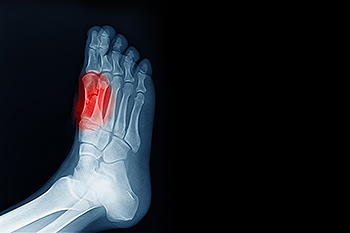
The sesamoid bones are two small, round bones located beneath the big toe joint, embedded within a tendon. While these bones are essential for foot function, they are susceptible to various issues. One common cause of sesamoid problems is excessive pressure or repetitive stress, often seen in athletes, particularly those engaging in activities like running, dancing, or ballet. High-heeled shoes can also put extra pressure on these bones, leading to discomfort. Injuries, such as a direct blow to the sesamoids or a forceful hyperextension of the big toe, can result in fractures or inflammation. Additionally, foot structure abnormalities like a high arch or a pronated foot can increase the risk of sesamoiditis. Conditions such as osteoarthritis or gout can contribute to sesamoid issues by affecting the surrounding joints. Wearing proper footwear, orthotic support, and rest are often essential components of treatment, while severe cases may require surgical intervention. If you have pain under the big toe, it is suggested that you confer with a podiatrist who can accurately diagnose and treat sesamoiditis.
Sesamoiditis is an unpleasant foot condition characterized by pain in the balls of the feet. If you think you’re struggling with sesamoiditis, contact one of our podiatrists of Preferred Footcare, LLC. Our doctors will treat your condition thoroughly and effectively.
Sesamoiditis
Sesamoiditis is a condition of the foot that affects the ball of the foot. It is more common in younger people than it is in older people. It can also occur with people who have begun a new exercise program, since their bodies are adjusting to the new physical regimen. Pain may also be caused by the inflammation of tendons surrounding the bones. It is important to seek treatment in its early stages because if you ignore the pain, this condition can lead to more serious problems such as severe irritation and bone fractures.
Causes of Sesamoiditis
- Sudden increase in activity
- Increase in physically strenuous movement without a proper warm up or build up
- Foot structure: those who have smaller, bonier feet or those with a high arch may be more susceptible
Treatment for sesamoiditis is non-invasive and simple. Doctors may recommend a strict rest period where the patient forgoes most physical activity. This will help give the patient time to heal their feet through limited activity. For serious cases, it is best to speak with your doctor to determine a treatment option that will help your specific needs.
If you have any questions please feel free to contact our office located in Stamford, CT . We offer the newest diagnostic and treatment technologies for all your foot and ankle needs.
Arthritis Can Cause Pain in the Feet and Ankles
Causes of a Sore Toe
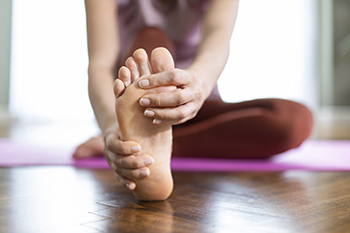
Toe pain can result from various causes, often associated with factors such as excessive exercise or wearing ill-fitting shoes. Identifying the source of your discomfort can be aided by recognizing specific symptoms. Some potential causes of toe pain can include an ingrown toenail, a bunion, Raynaud’s, or Chilblains. A broken toe or gout can also result in an ingrown toenail which can happen from the toenail curving into the skin of the toe. A bunion is a hard, bony lump near the big toe. Raynaud’s or Chilblains refers to pain, tingling, and numbness experienced in the toes, particularly when they are exposed to cold or stress, possibly leading to changes in color. A broken toe creates swelling, redness, and bruising of the affected toe making it painful to walk. Gout typically affects the big toe joint with a sudden onset of pain, stiffness, and red or hot swollen skin around the toe joint. If you have toe pain and are uncertain about its cause, it is suggested that you make an appointment with a podiatrist for a proper diagnosis and treatment.
Toe pain can disrupt your daily activities. If you have any concerns, contact one of our podiatrists of Preferred Footcare, LLC. Our doctors can provide the care you need to keep you pain-free and on your feet.
What Causes Toe Pain?
Most severe toe pain is caused due to a sports injury, trauma from dropping something heavy on the toe, or bumping into something rigid. Other problems can develop over time for various reasons.
Toe pain can be caused by one or more ailments. The most common include:
- Trauma
- Sports injury
- Wearing shoes that are too tight
- Arthritis
- Gout
- Corns and calluses
- Hammertoe
- Bunions
- Blisters
- Ingrown toenails
- Sprains
- Fractures (broken bones)
- Dislocations
When to See a Podiatrist
- Severe pain
- Persistent pain that lasts more than a week
- Signs of infection
- Continued swelling
- Pain that prevents walking
Diagnosis
In many cases the cause of toe pain is obvious, but in others, a podiatrist may want to use more advanced methods to determine the problem. These can range from simple visual inspections and sensation tests to X-rays and MRI scans. Prior medical history, family medical history, and any recent physical traumatic events will all be taken into consideration for a proper diagnosis.
Treatment
Treatments for toe pain and injuries vary and may include shoe inserts, padding, taping, medicines, injections, and in some cases, surgery. If you believe that you have broken a toe, please see a podiatrist as soon as possible.
If you have any questions please feel free to contact our office located in Stamford, CT . We offer the newest diagnostic tools and technology to treat your foot and ankle needs.
Coping With Cracked Heels for Soft and Healthy Feet
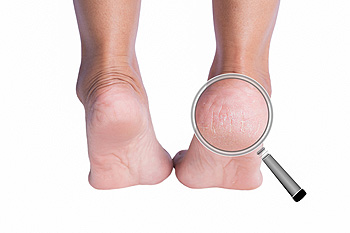
Cracked heels can be painful and unsightly, affecting your confidence and overall foot health. These dry, fissured heels often result from factors such as dry weather, inadequate foot care, or underlying medical conditions. The good news is that with appropriate care, you can nurse your feet back to health. This can begin with moisturizing regularly with a thick, hydrating cream designed for feet. This can help to soften the skin and prevent further cracking. Exfoliation can also be beneficial for removing dead skin cells and can be done by using a pumice stone or a foot file. It is important to avoid excessive soaking, as it can worsen the problem. Instead, maintain a balance between moisture and dryness. Consider wearing supportive, well-fitting shoes, as open-back or ill-fitting footwear can do further damage. For severe cases or if you notice signs of infection, consult a podiatrist. Remember, patience is key in dealing with cracked heels, so stick to your routine, and your feet will thank you with their renewed softness and comfort.
If the skin on your feet starts to crack, you may want to see a podiatrist to find treatment. If you have any concerns, contact one of our podiatrists from Preferred Footcare, LLC. Our doctors can provide the care you need to keep you pain-free and on your feet.
Cracked Heels
It is important to moisturize your cracked heels in order to prevent pain, bleeding, and infection. The reason cracked heels form is because the skin on the foot is too dry to support the immense pressure placed on them. When the foot expands, the dry skin on the foot begins to split.
Ways to Help Heal Them
- Invest in a good foot cream
- Try Using Petroleum Jelly
- Ease up on Soaps
- Drink Plenty of Water
Ways to Prevent Cracked Heels
- Moisturize After Showering
- Skip a Shower
- Keep Shower Water Lukewarm
- Don’t Scrub Your Feet
If you are unsure how to proceed in treating cracked heels, seek guidance from a podiatrist. Your doctor will help you with any questions or information you may need.
If you have any questions, please feel free to contact our office located in Stamford, CT . We offer the newest diagnostic and treatment technologies for all your foot care needs.









